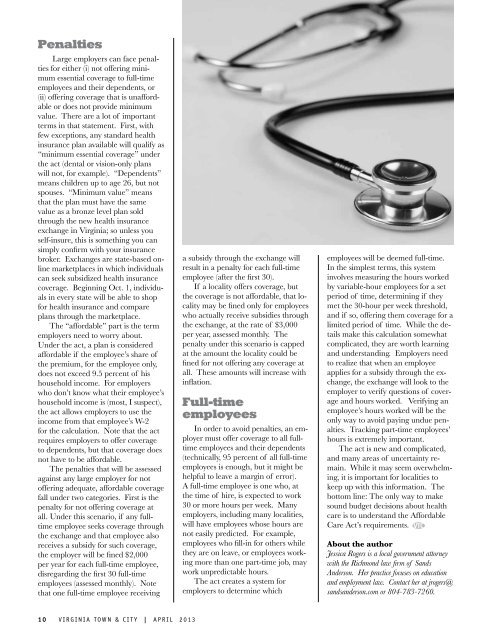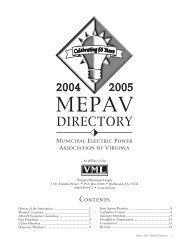PenaltiesLarge employers can face penaltiesfor ei<strong>the</strong>r (i) not offering minimumessential coverage to full-timeemployees and <strong>the</strong>ir dependents, or(ii) offering coverage that is unaffordableor does not provide minimumvalue. There are a lot of importantterms in that statement. First, withfew exceptions, any standard healthinsurance plan available will qualify as“minimum essential coverage” under<strong>the</strong> act (dental or vision-only planswill not, for example). “Dependents”means children up to age 26, but notspouses. “Minimum value” meansthat <strong>the</strong> plan must have <strong>the</strong> samevalue as a bronze level plan soldthrough <strong>the</strong> new health insuranceexchange in <strong>Virginia</strong>; so unless youself-insure, this is something you cansimply confirm with your insurancebroker. Exchanges are state-based onlinemarketplaces in which individualscan seek subsidized health insurancecoverage. Beginning Oct. 1, individualsin every state will be able to shopfor health insurance and compareplans through <strong>the</strong> marketplace.The “affordable” part is <strong>the</strong> termemployers need to worry about.Under <strong>the</strong> act, a plan is consideredaffordable if <strong>the</strong> employee’s share of<strong>the</strong> premium, for <strong>the</strong> employee only,does not exceed 9.5 percent of hishousehold income. For employerswho don’t know what <strong>the</strong>ir employee’shousehold income is (most, I suspect),<strong>the</strong> act allows employers to use <strong>the</strong>income from that employee’s W-2for <strong>the</strong> calculation. Note that <strong>the</strong> actrequires employers to offer coverageto dependents, but that coverage doesnot have to be affordable.The penalties that will be assessedagainst any large employer for notoffering adequate, affordable coveragefall under two categories. First is <strong>the</strong>penalty for not offering coverage atall. Under this scenario, if any fulltimeemployee seeks coverage through<strong>the</strong> exchange and that employee alsoreceives a subsidy for such coverage,<strong>the</strong> employer will be fined $2,000per year for each full-time employee,disregarding <strong>the</strong> first 30 full-timeemployees (assessed monthly). Notethat one full-time employee receivinga subsidy through <strong>the</strong> exchange willresult in a penalty for each full-timeemployee (after <strong>the</strong> first 30).If a locality offers coverage, but<strong>the</strong> coverage is not affordable, that localitymay be fined only for employeeswho actually receive subsidies through<strong>the</strong> exchange, at <strong>the</strong> rate of $3,000per year, assessed monthly. Thepenalty under this scenario is cappedat <strong>the</strong> amount <strong>the</strong> locality could befined for not offering any coverage atall. These amounts will increase withinflation.Full-timeemployeesIn order to avoid penalties, an employermust offer coverage to all fulltimeemployees and <strong>the</strong>ir dependents(technically, 95 percent of all full-timeemployees is enough, but it might behelpful to leave a margin of error).A full-time employee is one who, at<strong>the</strong> time of hire, is expected to work30 or more hours per week. Manyemployers, including many localities,will have employees whose hours arenot easily predicted. For example,employees who fill-in for o<strong>the</strong>rs while<strong>the</strong>y are on leave, or employees workingmore than one part-time job, maywork unpredictable hours.The act creates a system foremployers to determine whichemployees will be deemed full-time.In <strong>the</strong> simplest terms, this systeminvolves measuring <strong>the</strong> hours workedby variable-hour employees for a setperiod of time, determining if <strong>the</strong>ymet <strong>the</strong> 30-hour per week threshold,and if so, offering <strong>the</strong>m coverage for alimited period of time. While <strong>the</strong> detailsmake this calculation somewhatcomplicated, <strong>the</strong>y are worth learningand understanding. Employers needto realize that when an employeeapplies for a subsidy through <strong>the</strong> exchange,<strong>the</strong> exchange will look to <strong>the</strong>employer to verify questions of coverageand hours worked. Verifying anemployee’s hours worked will be <strong>the</strong>only way to avoid paying undue penalties.Tracking part-time employees’hours is extremely important.The act is new and complicated,and many areas of uncertainty remain.While it may seem overwhelming,it is important for localities tokeep up with this information. Thebottom line: The only way to makesound budget decisions about healthcare is to understand <strong>the</strong> <strong>Affordable</strong><strong>Care</strong> <strong>Act</strong>’s requirements.About <strong>the</strong> authorJessica Rogers is a local government attorneywith <strong>the</strong> Richmond law firm of SandsAnderson. Her practice focuses on educationand employment law. Contact her at jrogers@sandsanderson.com or 804-783-7260.10 <strong>Virginia</strong> Town & City | april 2013
Federal court rules against prayersat government meetings ... againThe First Amendment to <strong>the</strong>constitution: Congress shall make nolaw respecting an establishment of religion,or prohibiting <strong>the</strong> free exercise <strong>the</strong>reof ....Over <strong>the</strong> last nine years,<strong>the</strong> U.S. Court of Appealsfor <strong>the</strong> 4 th Circuit and <strong>the</strong>federal district courts in<strong>the</strong> circuit have ruledrepeatedly that sectarianprayers delivered at local governmentmeetings violate <strong>the</strong> First Amendment’sEstablishment Clause. Themost recent case – Hudson v. PittsylvaniaCounty, Va., – involves <strong>the</strong> PittsylvaniaCounty Board of Supervisors andcounty resident Barbara Hudson.The federal district court issued aruling on March 27.At <strong>the</strong> heart of <strong>the</strong> dispute was<strong>the</strong> county board’s regular practiceof beginning its meetings with aninvocation that invoked <strong>the</strong> name ofJesus. After Hudson complained, <strong>the</strong>board adopted a non-sectarian prayerpolicy, but <strong>the</strong> practice of praying in<strong>the</strong> name of Jesus continued. Hudsontestified that at <strong>the</strong> board meetingfollowing her letter of complaint to<strong>the</strong> county attorney that all sevenboard members offered Christianprayers to start <strong>the</strong> meeting. In <strong>the</strong>past, only one prayer was offered. Inaddition, after <strong>the</strong> board adopted <strong>the</strong>non-sectarian prayer policy, <strong>the</strong> courtnoted that <strong>the</strong> board invited ministersto <strong>the</strong> public comment period, where<strong>the</strong>y prayed Christian prayers, withseveral board members standing andjoining in with “Amens.”Here is an example of <strong>the</strong> invocationsthat <strong>the</strong> court had to deal with:“Gracious heavenly fa<strong>the</strong>r, we thankyou for <strong>the</strong> opportunity to addressyou, and thank you O Lord, becauseyou made all of this possible. Youare our God, you are our King, youare <strong>the</strong> reason we are here. God,without you, and Jesus, without you,<strong>the</strong>re would be no life on earth, andwe would not be able to sit downand express our Christian valuesbefore <strong>the</strong> good people of PittsylvaniaBy Mark K. FlynnCounty. Amen.”In its decision, <strong>the</strong> federal districtcourt relied on <strong>the</strong> previous rulingsof <strong>the</strong> appeals court on <strong>the</strong> standardfor official prayers and o<strong>the</strong>rprayers sanctioned by a public body:“Legislative prayer must strive to benondenominational so long as that isreasonably possible – itshould send a signal ofwelcome ra<strong>the</strong>r thanexclusion. It should not reject <strong>the</strong>tenets of o<strong>the</strong>r faiths in favor of justone. Infrequent references to specificdeities, standing alone, do not sufficeto make out a constitutional case.But legislative prayers that go fur<strong>the</strong>r– prayers in a particular venue thatrepeatedly suggest <strong>the</strong> governmenthas put its weight behind a particularfaith – transgress <strong>the</strong> boundaries of<strong>the</strong> Establishment Clause. Faith isas deeply important as it is deeplypersonal, and <strong>the</strong> government shouldnot appear to suggest that some faithshave it wrong and o<strong>the</strong>rs got it right.”Following that standard, <strong>the</strong> courtruled that <strong>the</strong> practice of <strong>the</strong> countyboard of supervisors violated <strong>the</strong>Establishment Clause of <strong>the</strong> FirstAmendment.The court also commented onano<strong>the</strong>r, typical undercurrent in thiskind of case – that <strong>the</strong> plaintiff was “acontentious character” in <strong>the</strong> county.The court noted: “Hudson’s historicrole as a board antagonist is beside<strong>the</strong> point. The fact that Hudson hasclashed with <strong>the</strong> board in <strong>the</strong> pastcannot absolve <strong>the</strong> board of its clearviolation of <strong>the</strong> Establishment Clauseor change <strong>the</strong> fact that Hudsonpersonally experienced <strong>the</strong> board’spractice of opening each meeting witha Christian prayer that was offensiveto her.”The prior cases that <strong>the</strong> districtcourt relied on are: Wynne v. Townof Great Falls (2004), where <strong>the</strong> 4 thCircuit struck down official, sectarianprayers by a town council; and Turnerv. City Council of Fredericksburg (2008),where <strong>the</strong> 4 th Circuit again foundthat <strong>the</strong> invocation at <strong>the</strong> beginningof a meeting is an official prayer thatmust be non-sectarian. In <strong>the</strong> Turnercase, a council member who was aminister refused to comply with <strong>the</strong>council’s non-sectarian prayer policyand sued – unsuccessfully – when <strong>the</strong>council would not allow him to give<strong>the</strong> opening prayer. Rev. HashmelTurner argued that <strong>the</strong> policy violatedhis freedom of religion. The courtdisagreed, due to <strong>the</strong> prayer beingan official prayer as a part of <strong>the</strong>meeting. The most recent 4 th Circuitcase was Joyner v. Forsyth County (2011),which was factually similar to <strong>the</strong>Pittsylvania County case.The lesson from <strong>the</strong> federal caselaw that controls <strong>Virginia</strong> is clear:When prayers are part of a localgoverning body’s meetings, <strong>the</strong>prayers are official speech. If <strong>the</strong>governing body by rule (prayer policy)or practice (what <strong>the</strong>y do in <strong>the</strong> meetings)regularly allows sectarian prayersof any kind, that is a violation of <strong>the</strong>Establishment Clause of <strong>the</strong> FirstAmendment. This law is as settled asany o<strong>the</strong>r legal principle in <strong>the</strong> 4 th Circuit,which includes <strong>Virginia</strong>, NorthCarolina, South Carolina, Marylandand West <strong>Virginia</strong>.It may be frustrating to somelocal elected officials not to be ableto pray as <strong>the</strong>y see fit, but <strong>the</strong> lawis clear. Governing bodies have aresponsibility to uphold <strong>the</strong> FirstAmendment by taking <strong>the</strong> stepsnecessary to avoid sectarian prayersduring <strong>the</strong>ir meetings.About <strong>the</strong> authorMark K. Flynn is general counsel for <strong>the</strong><strong>Virginia</strong> <strong>Municipal</strong> <strong>League</strong>.VIRGINIA TOWN & CITY | april 2013 11









